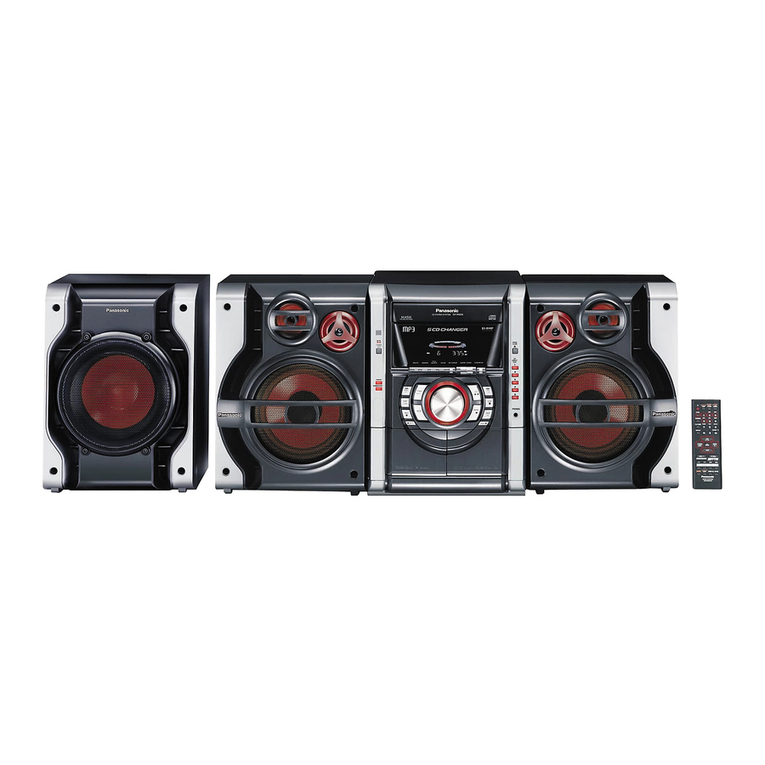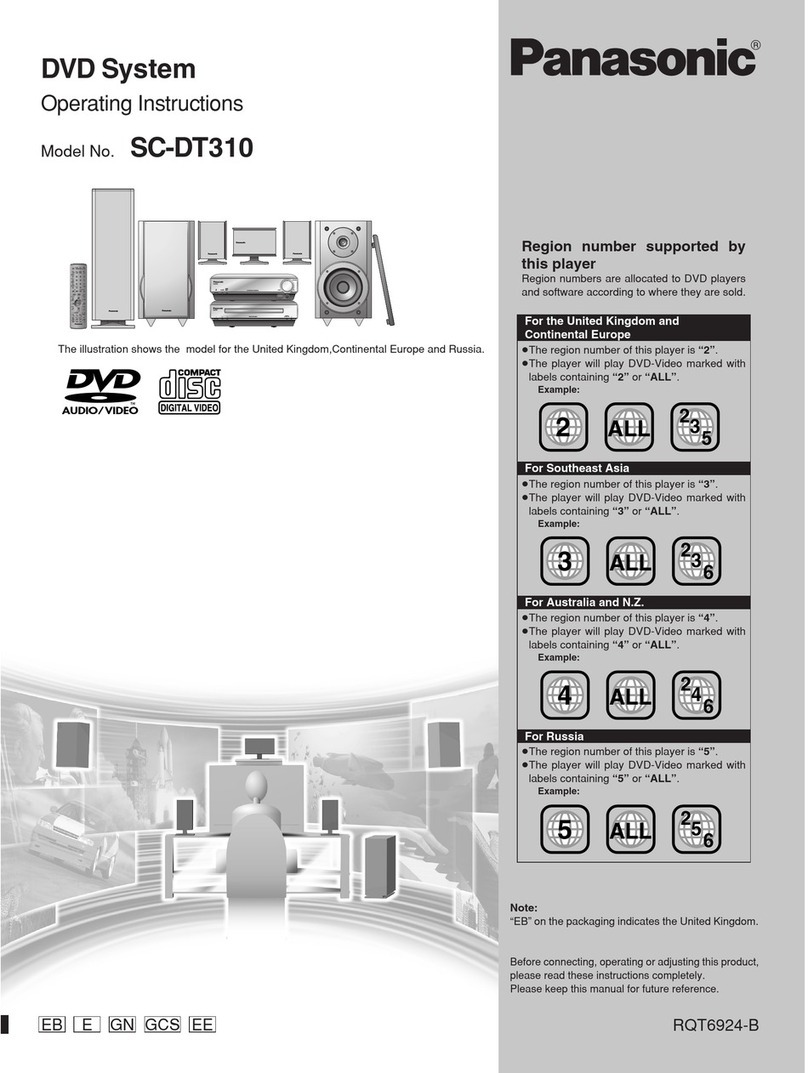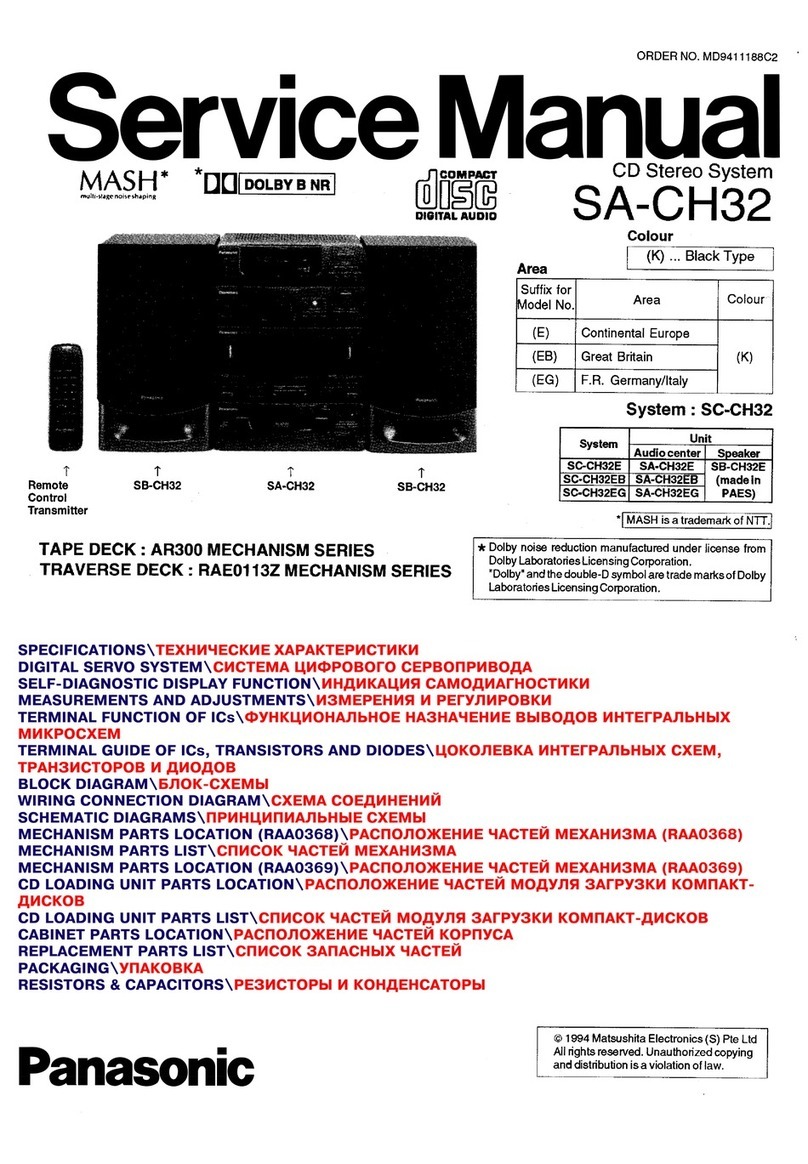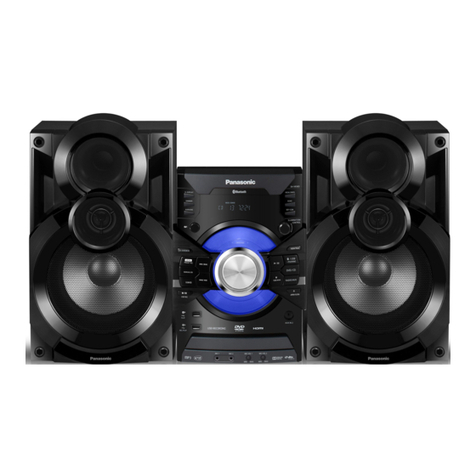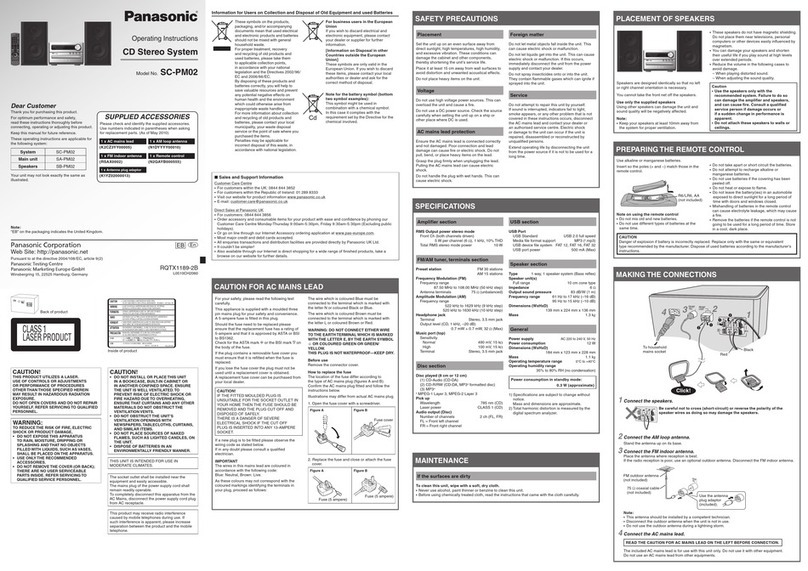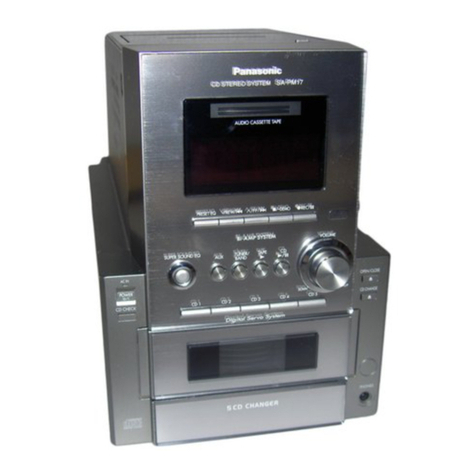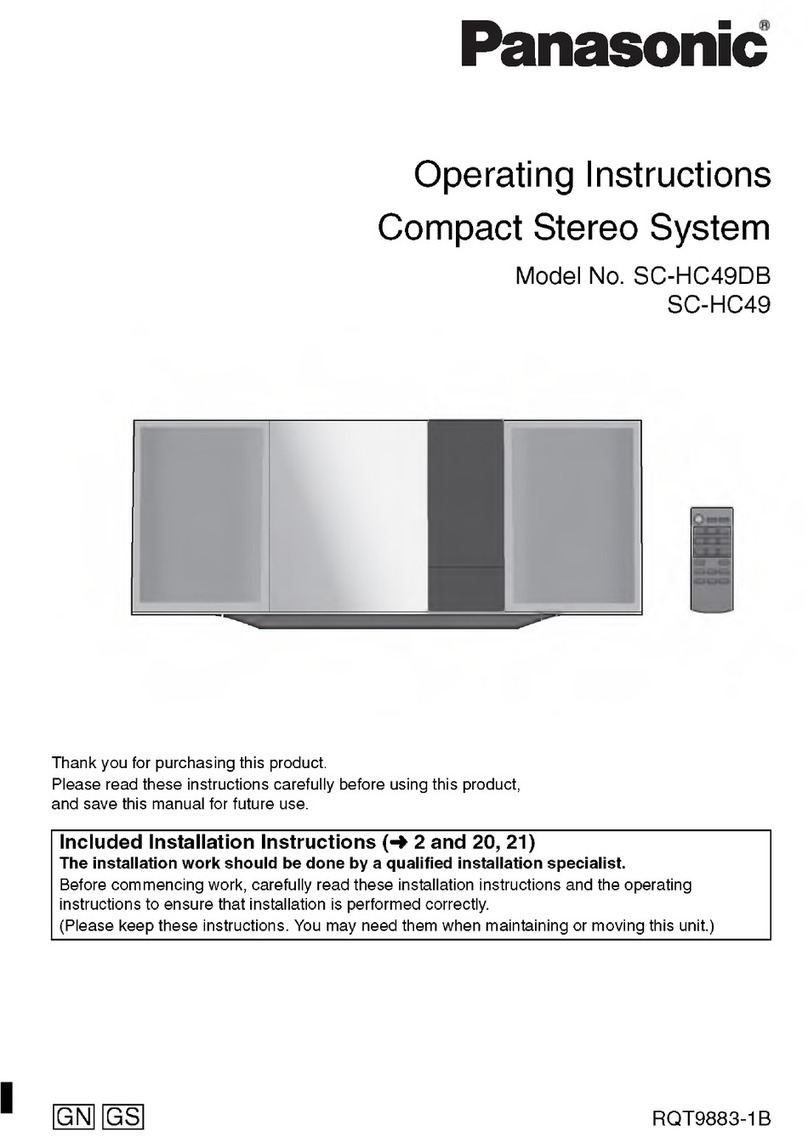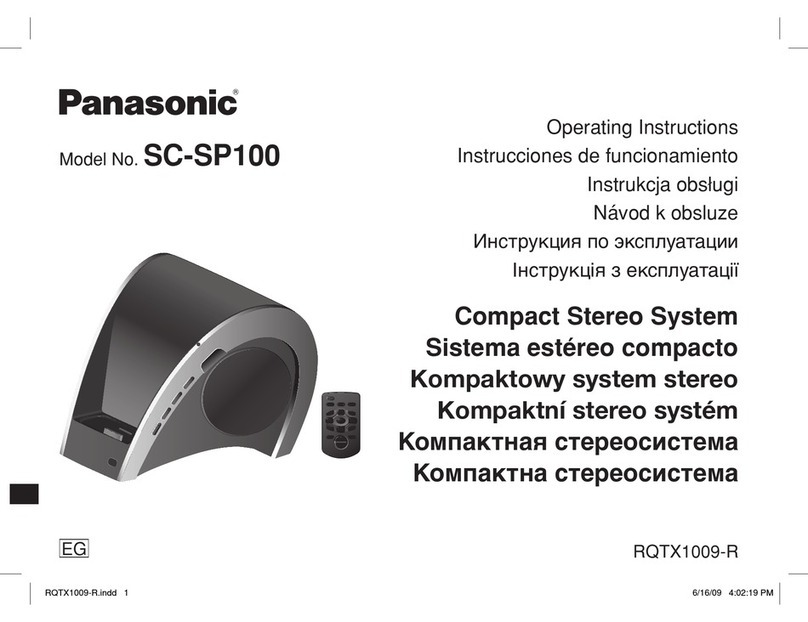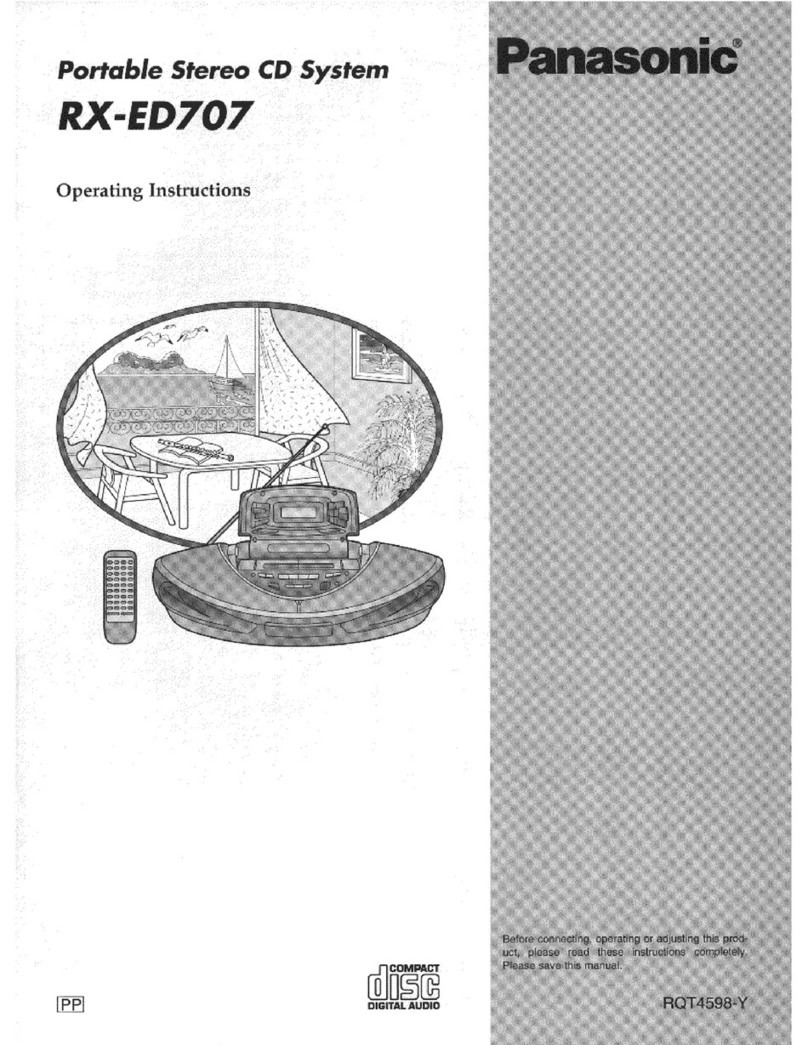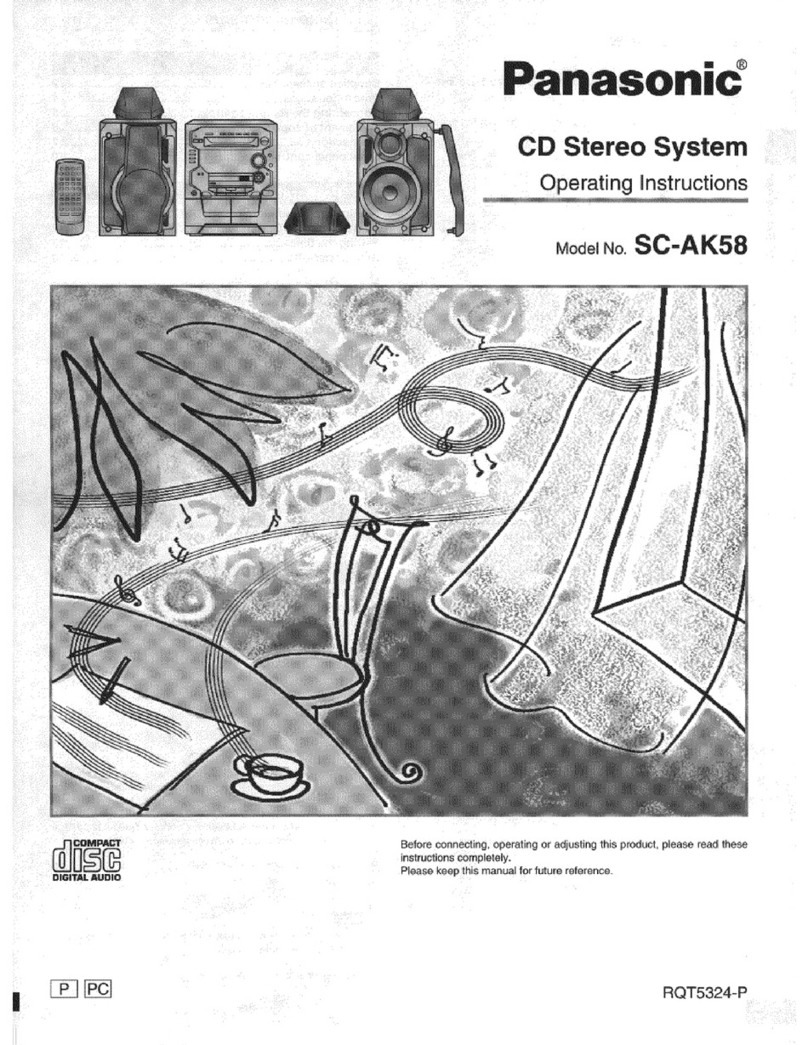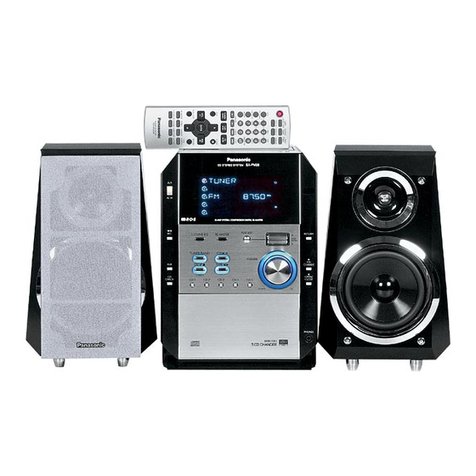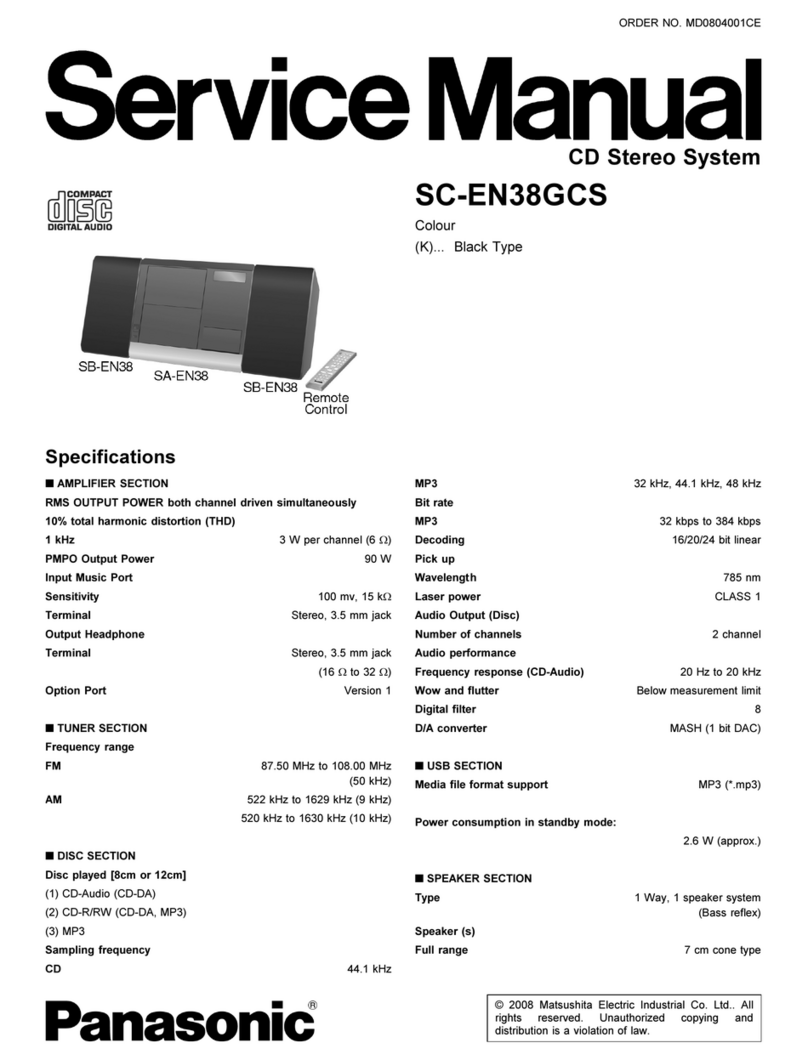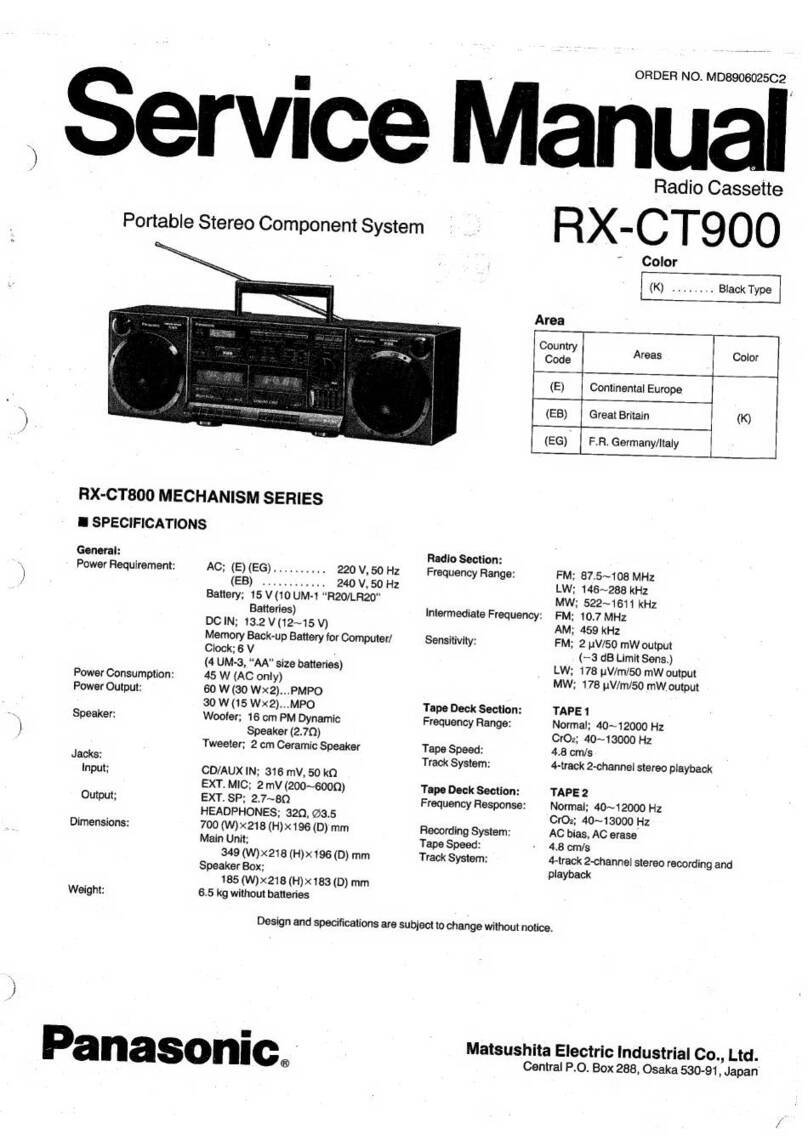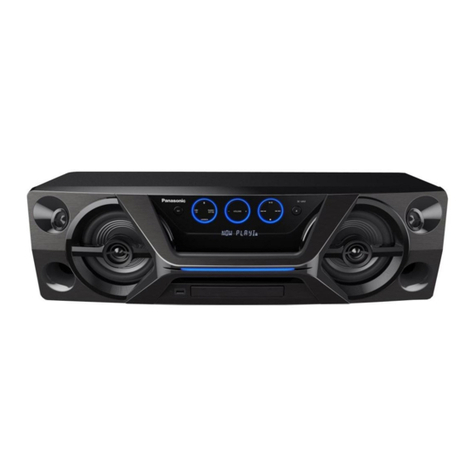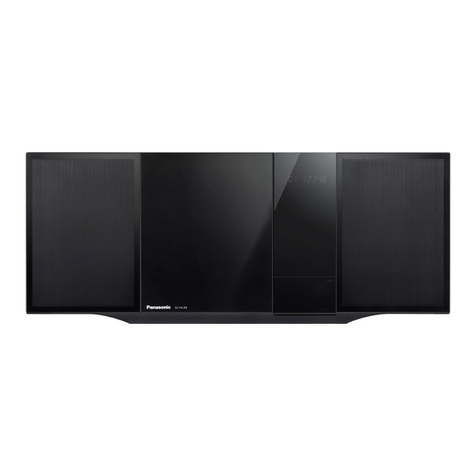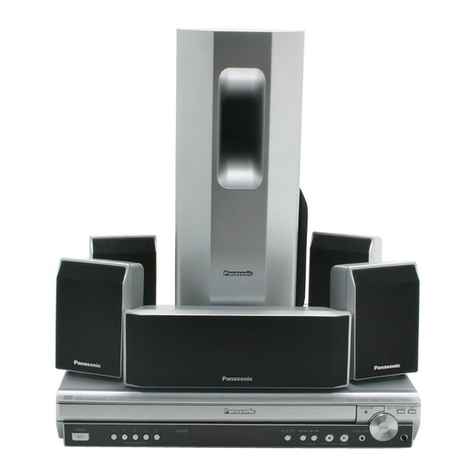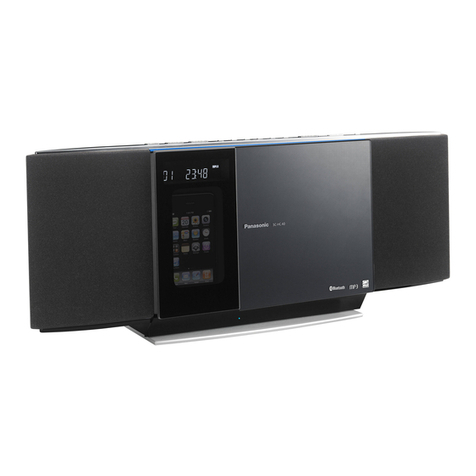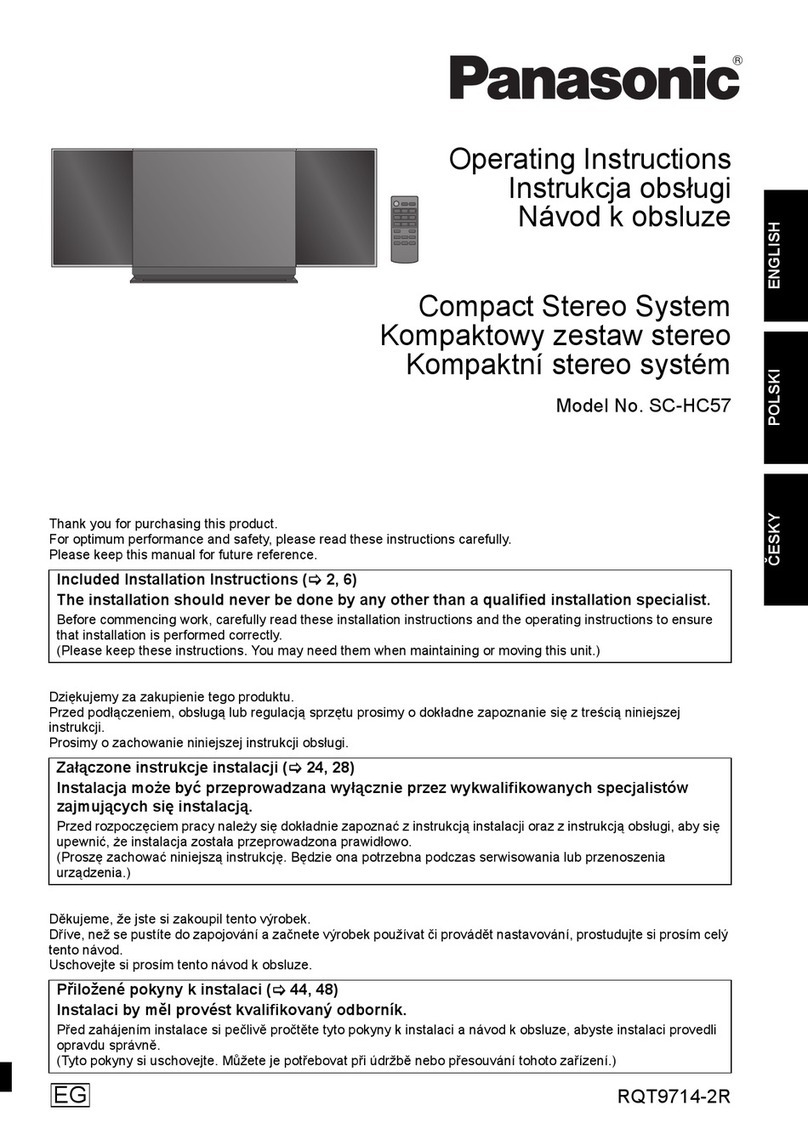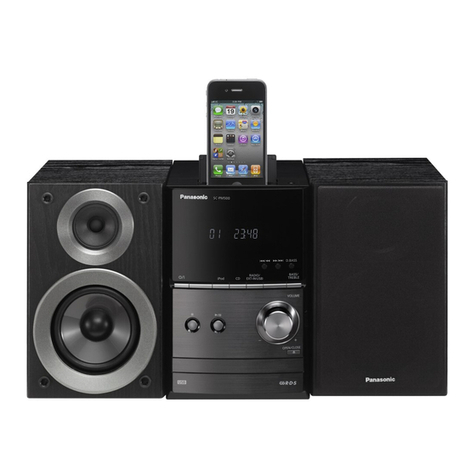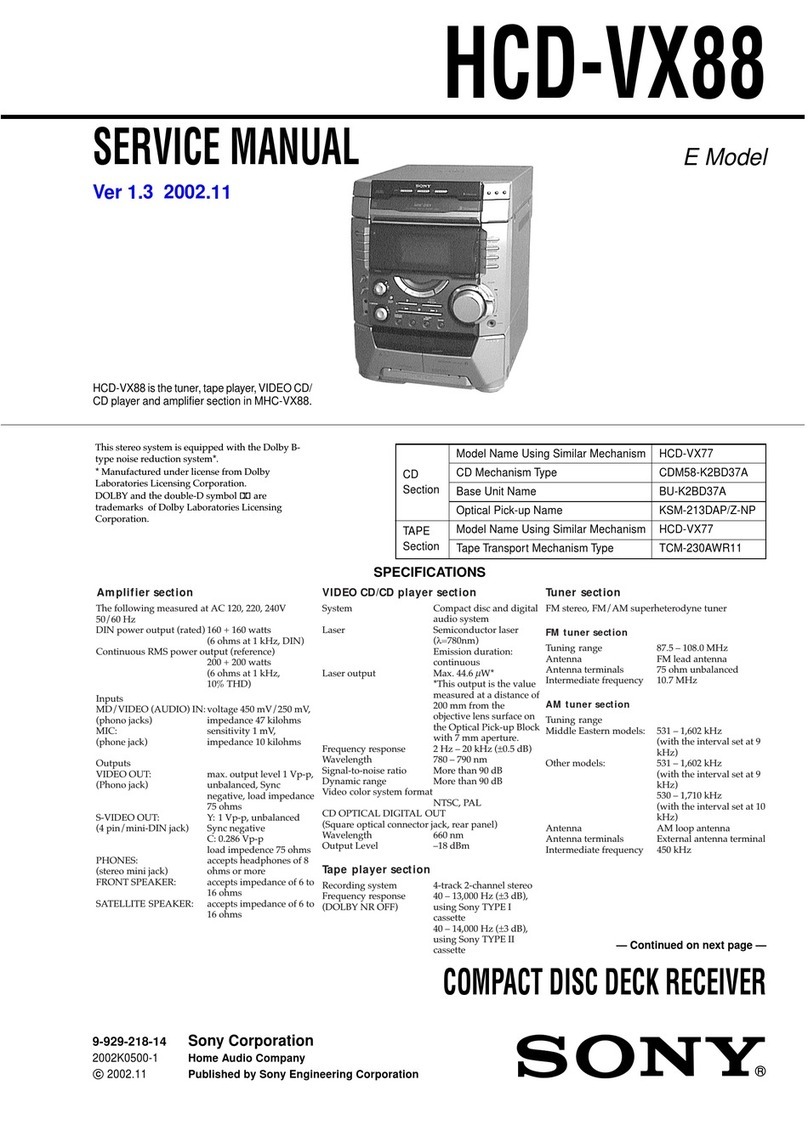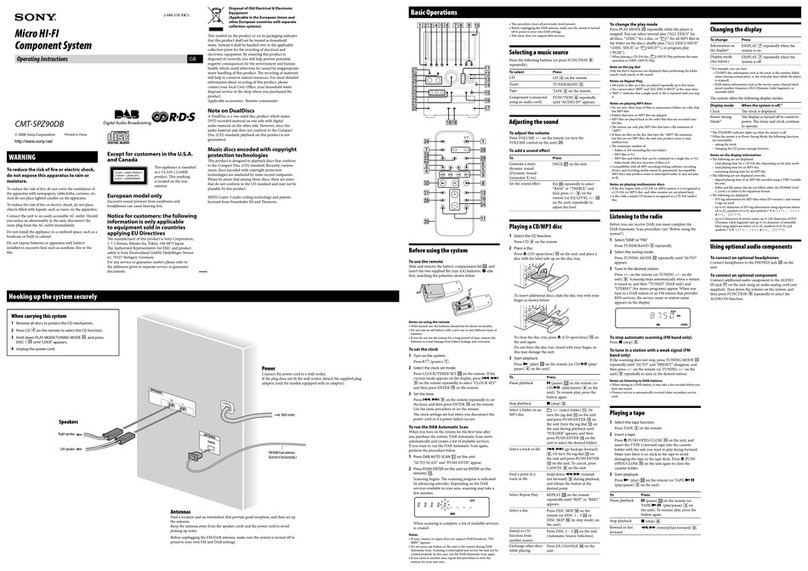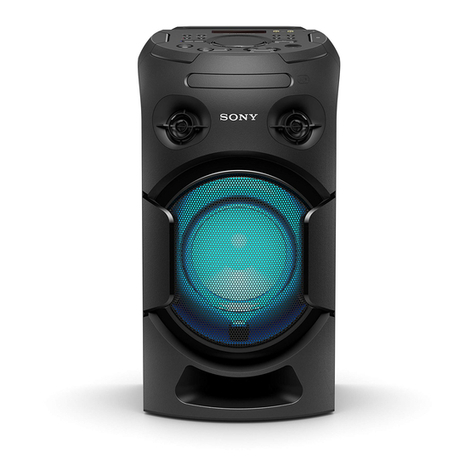
Clean
the
cabinet,
panel
and
controls
with
a
soft
cloth
lightly
moistened
with
mild
detergent
solution.
Do
not
use
any
type
of
abrasive
pad,
scouring
powder
or
solvent
such
as
alcohol
or
benzine.
.
Damage
Requiring
Service—The
unit
should
be
serviced
by
quali-
fied
service
personnel
when:
(a)
The
AC
power
supply
cord
or
the
plug
has
been
damaged;
or
(b)
Objects
have
fallen
or
liquid
has
been
spilled
into
the
unit;
or
(c)
The
unit
has
been
exposed
to
rain;
or
{d)
The
unit
does
not
appear
to
operate
normally
or
exhibits
a
marked
change
in
performance;
or
(e)
The
unit
has
been
dropped,
or
the
enclosure
damaged.
Servicing—The
user
should
not
attempt
to
service
the
unit
beyond
that
described
in
the
operating
instructions.
All
other
servicing
should
be
referred
to
an
authorized
service
personnel.
For
the
address
of
an
authorized
servicenter:
in
the
U.S.A.
1-800-211-7262
or
web
site
(http://www.panasonic.com)
in
Canada
905-624-5505
or
web
site
(www.panasonic.ca/fdbckca.htm)
mb
THE
FOLLOWING
APPLIES
ONLY
IN
THE
U.S.A.:
CAUTION:
This
equipment
has
been
tested
and
found
to
comply
with
the
lim-
its
for
a
Class
B
digital
device,
pursuant
to
Part
15
of
the
FCC
Rules.
These
limits
are
designed
to
provide
reasonable
protection
against
harmful
interference
in
a.residential
installation.
This
equipment
generates,
uses
and
can
radiate
radio
frequency
ener-
gy
and,
if
not
installed
and
used
in
accordance
with
the
instruc-
tions,
may
Cause
harmful
interference
to
radio
communications.
However,
there
is
no
guarantee
that
interference
will
not
occur
in
a
particular
installation.
If
this
equipment
does
cause
harmful
in-
terference
to
radio
or
television
reception,
which
can
be
deter-
mined
by
turning
the
equipment
off
and
on,
the
user
is
encour-
aged
to
try
to
correct
the
interference
by
one
of
the
following
-
measures:
e
Reorient
or
relocate
the
receiving
antenna.
increase
the
separation
between
the
equipment
and
receiver,
e@Connect
the
equipment
into
an
outlet
on
a
circuit
different
from
that
to
which
the
receiver
is
connected.
Consult
the
dealer
or
an
experienced
radio/TV
technician
tor
help.
FCC
Notice:
This
system
complies
with
new
Part
15,
except
for
the
radio
receiver,
which
complies
with
old
Part
15,
Subpart
C
of
the
FCC
Rules.
Operation
is
subject
to
the
following
two
condi-
tions:
(1)
This
device
may
not
cause
harmful
interference,
and
(2)
this
device
must
accept
any
interference
received,
including
inter-
ference
that
may
cause
undesirable
operation.
The
radio
receiver
is
not
subject
to
above
item
(2).
Any
unauthorized
changes
or
modifications
to
this
equipment
would
void
the
user's
authority
to
operate
this
device.
Q
Selecting
fine
audio
equipment
such
as
the
unit
you've
just
purchased
is
only
the
start
of
your
musical
enjoyment.
Now
it’s
time
to
consider
how
you
can
maximize
the fun
and
excitement
your
equipment
offers.
This
manufacturer
and
the
Electronic
Industries
Association’s
Consumer
Electronics
Group
want
you
to
get
the
most
out
of
your
equipment
by
playing
it
at
a
safe
level.
One
that
lets
the
sound
come
through
loud
and
clear
without
annoying
blaring
or
distortion—and,
most
importantly,
with-
out
affecting
your
sensitive
hearing.
We
recommend
you
to
avoid
prolonged
exposure
to
excessive
noise.
Sound
can
be
deceiving.
Over
time
your
hearing
“comfort
level”
adapts
to
higher
volumes
of
sound.
So
what
sounds
“normal”
can
actually
be
loud
and
harmful
to
your
hearing.
Guard
against
this
by
setting
your
equipment
at
a
safe
level
BEFORE
your
hearing
adapts.
To
establish
a
safe
level:
eStart
your
volume
control
at
a
low
setting.
e
Slowly
increase
the
sound
until
you
can
hear
it
comfortably
and
clearly,
and
without
distortion.
Once
you
have
established
a
comfortable
sound
level:
Set
the
dial
and
leave
it
there.
Taking.
a
minute
to
do
this
now
will
help
to
prevent
hearing
damage
or
loss
in
the
future.
After
all,
we
want
you
listening
for
a
lifetime.
Product
service
Do
not
attempt
to
remove
the
cover(s)
or
repair
the
unit
yourself.
Refer
servicing
to
qualified
personnel
only.
Product
information
For
product
service,
product
information
or
assistance
in
product
operation,
refer
to
the
servicenter
directory.
Use
of
batteries
Do
not
use
rechargeable
type
batteries.
Do
not
mix
old
and
new
batteries,
or
batteries
of
different
types
(man-
ganese
and
alkaline,
etc.)
@Always
remove
old,
weak
or
worn-out
batteries
promptly
and
dispose
of
them
properly.
Never
subject
batteries
to
excessive
heat
or
flame;
do
not
attempt
to
disassemble
them,
and
be
sure
they
are
not
short-circuited.
elf
this unit
is
not
to
be
used
for
a
long
period
of
time
or
is
used
only
from
an
AC
power
source,
remove
the
batteries
and
store
them
in
a
cool,
dark
place.
elf
a
battery
leaks,
remove
all
batteries
and
dispose
of
them
properly.
Thoroughly
clean
the
battery
compartment
before
inserting
new
batteries.
elf
the
electrolyte
comes
into
contact
with skin
or
clothes,
flush
with
water
immediately.
Keep
batteries
out
of
reach
of
children.
e
Do
not
attempt
to
recharge
alkaline
or
manganese
batteries.
®Batteries
installed
with
incorrect
polarities
may
leak
and
damage
the
unit.
